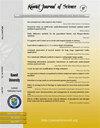用海藻酸钠-阿拉伯胶复合物制备omega-3脂肪酸纳米胶囊:体外消化率和生物相容性治疗潜力
IF 1.1
4区 综合性期刊
Q3 MULTIDISCIPLINARY SCIENCES
引用次数: 0
摘要
Omega-3脂肪酸(ω3FAs)具有多种健康益处,但由于溶解度有限和易氧化而面临挑战。在本研究中,开发了海藻酸钠-金合欢胶(SA-AG)配合物来解决这些问题。通过zeta电位和热重分析证实了配合物的稳定性。ω3FAs包封在SA-AG配合物中,并对其物理、形态和化学特性进行了评价。采用体外模拟消化法评价包封的ω3FAs (ω3FAs)的生物可及性,并进行抗氧化、抗菌和毒性试验。SA-AG配合物的zeta电位为- 40.3±9.48 mV,在240℃下保持稳定。该配合物的氧化稳定性在配制后维持了90天。平均粒径为961.9 nm,呈球形结构。能量色散x射线分析(EDAX)证实了ω3FAs在特定波段(0.05,0.5和1 - 1.2 KeV)的存在,傅里叶变换红外(FT-IR)分析证实了ω3FAs在特定波段(3301 cm−1和1630 cm−1)的官能团。ω3FAs在胃肠道条件下表现出快速释放,从45分钟开始,脂解率为40%。ω3FAs在DPPH浓度为2 mg/ml时的抗氧化活性最高(35±3.8%),5.12 mg/ml时的铁还原抗氧化能力为48.85±0.002%,5.12 mg/ml时的一氧化氮为20.71±0.95 nmol, 5.12 mg/ml时的脂质过氧化吸光度为0.204±0.001。Enω3FAs对大肠杆菌、肺炎链球菌和铜绿假单胞菌的最低抑菌浓度为64 mg/ml,对金黄色葡萄球菌的最低抑菌浓度为16 mg/ml。ω 3fas也证明了在浓度为4mg /ml时,能减少约50%的生物膜形成,并诱导现有生物膜减少30%。此外,Enω3FAs具有生物相容性,经治疗24 h后死亡率为0%。综上所述,ω 3fas在稳定的SA-AG复合物配方中显示出治疗潜力,为药物和食品输送系统提供了一种有前景的方法。本文章由计算机程序翻译,如有差异,请以英文原文为准。
Fabrication of omega-3 fatty acid nanoencapsulation with a sodium alginate-acacia gum complex: In vitro digestibility and biocompatible therapeutic potential
Omega-3 fatty acids (ω3FAs) possess various health benefits but face challenges due to limited solubility and susceptibility to oxidation. In this study, a sodium alginate-acacia gum (SA-AG) complex was developed to address these issues. The stability of the complex was confirmed through zeta potential and thermogravimetric analysis. ω3FAs were encapsulated within the SA-AG complex, and their physical, morphological, and chemical characteristics were evaluated. Simulated in vitro digestion was used to assess the bio-accessibility of the encapsulated ω3FAs (Enω3FAs), and antioxidant, antibacterial, and toxicity tests were conducted. The SA-AG complex exhibited a zeta potential of −40.3 ± 9.48 mV and remained stable up to 240 °C. The oxidative stability of the complex was maintained for up to 90 days post-formulation. The average particle size was 961.9 nm, with spherical structures observed. Energy Dispersive X-ray Analysis (EDAX) showed the presence of ω3FAs at specific peaks (0.05, 0.5, and 1–1.2 KeV), while Fourier Transform Infrared (FT-IR) analysis confirmed the functional groups of ω3FAs at specific bands (3301 cm−1 and 1630 cm−1). Enω3FAs exhibited rapid release of ω3FAs under gastrointestinal conditions, starting at 45 min with 40 % lipolysis. The highest antioxidant activities of ω3FAs were observed at a concentration of 2 mg/ml through DPPH (35 ± 3.8 %), ferric reducing antioxidant power (48.85 ± 0.002 %) at 5.12 mg/mL, 20.71 ± 0.95 nmol of nitric oxide at 5.12 mg/mL, and 0.204 ± 0.001 absorbance for lipid peroxidation at 5.12 mg/mL. The minimum inhibitory concentration of Enω3FAs was 64 mg/ml against E. coli, S. pneumoniae, and P. aeruginosa, and 16 mg/mL against S. aureus. Enω3FAs also demonstrated the ability to reduce biofilm formation by approximately 50 % and induce a 30 % reduction in existing biofilms at a concentration of 4 mg/ml. Additionally, Enω3FAs were found to be biocompatible, with 0 % mortality observed after 24 h of treatment on Artemia franciscana nauplii. In conclusion, Enω3FAs show therapeutic potential within a stable formulation using the SA-AG complex, providing a promising approach for drug and food delivery systems.
求助全文
通过发布文献求助,成功后即可免费获取论文全文。
去求助
来源期刊

Kuwait Journal of Science
MULTIDISCIPLINARY SCIENCES-
CiteScore
1.60
自引率
28.60%
发文量
132
期刊介绍:
Kuwait Journal of Science (KJS) is indexed and abstracted by major publishing houses such as Chemical Abstract, Science Citation Index, Current contents, Mathematics Abstract, Micribiological Abstracts etc. KJS publishes peer-review articles in various fields of Science including Mathematics, Computer Science, Physics, Statistics, Biology, Chemistry and Earth & Environmental Sciences. In addition, it also aims to bring the results of scientific research carried out under a variety of intellectual traditions and organizations to the attention of specialized scholarly readership. As such, the publisher expects the submission of original manuscripts which contain analysis and solutions about important theoretical, empirical and normative issues.
 求助内容:
求助内容: 应助结果提醒方式:
应助结果提醒方式:


